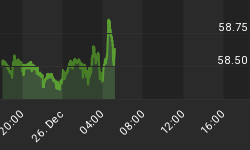What a shocker! What a week! What a mood swing! The major indexes fell heavily on Friday. The Dow was down 213 points (1.96%), the S&P 500 23 points (1.83%) and the Nasdaq Composite 54 points (2.35%). The large cap Nasdaq 100 fared even worse dropping 53 points (3.09%) while the S&P 600 small caps index dropped only 5 points (1.30%).
During the week there was a panic on the Tokyo stock exchange, a threat by Bin Laden, saber rattling by Iran and Israel, problems in Nigeria, an adverse shift in South America and disappointing earnings from some big name companies. Could it have been only the week before that the market was euphoric about the Fed stopping its rate increases soon and the Dow was soaring above 11,000?
The drop in the indexes caused a massive mood swing amongst investors. The week before the FIFTI¹ (Free Information From The Internet) Index of www.investorsinternet.com had the bulls in the majority in the short term. After Friday the percentage of bears amongst independent investment advisors with free newsletters and web sites jumped from 24% to 65%. The breakdown through technical support levels also shifted medium term opinions into negative territory with the percentage of bulls dropping from 52% to 18%, the lowest percentage of bulls since early October last year.
Similar jumps happened in other sentiment indexes. In the sentiment poll at www.stock-market-sentiment.com the percentage of bears doubled from Thursday to Friday. At www.lowrisk.com the percentage of bears rose from 29% to 55%.
The heavy down day in the indexes had some bad characteristics besides price. Volume was high. The VIX jumped from 11.98 to 14.56, and the VXN from 16.51 to 19.45. Increases of this magnitude in one day are rare, especially since volatility has been low in recent times. As John Murphy of www.stockcharts.com pointed out, this was accompanied by negative indications from the MACD and the RSI for the S&P 500 SPDRs. Many of the technical experts commented on the Dow breaking below 10,700 and suspected that it is heading for its 200 day moving average about 10,550.
Yet Friday was not all bad. Experts such as John Hussman at www.hussmanfunds.com and Brandon Frederickson at www.tradingfrommainstreet.com commented that the ratio of declining to advancing issues (2332 to 990 on the NYSE) was not that high, and the number of new highs exceeded the number of new lows by a wide margin (243 to 33). Nevertheless, most experts felt that a bottom had not been reached and that further downside was imminent.
The severe drop in the indexes gave the bears something to talk about other than the incessant drone about the (long-time) coming slowdown in consumer spending, the fall of the housing market, the inversion of the yield curve, foreign investors abandoning the dollar and geopolitical risks. It also created questions about the increasingly popular opinion that large caps are a better place to invest than small caps in the coming year. At the end of Friday the large cap Dow was down 0.47%, the large cap S&P 100 was up 0.26% whereas the small cap Russell 2000 was up 4.66% for this year.
As always, there are various opinions on what will happen from here. Will the market bounce and resume its New Year uptrend, or will the bounce be that of a dead cat? At least the technical experts are decided. The preponderance of opinion is clear that the Dow is headed down, at least to the vicinity of its 200 day moving average.
¹ The FIFTI Index is based on Free Information From The Internet, and in particular, on advice provided by fifty independent newsletter and Internet site writers selected from the book "The Investor's Free Internet". It is one of the tools that www.investorsinternet.com uses to gauge the stock market's direction for its Members and Subscribers.















